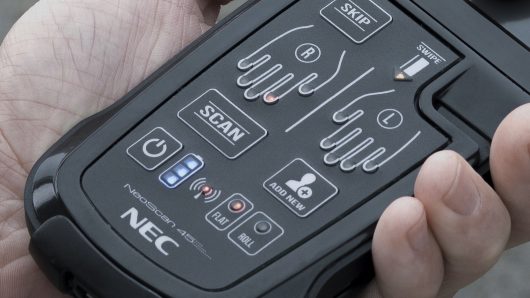Biometric Identification in Refugee Camps

The U.N. High Commissioner for Refugees (UNHCR) estimates that more than 65 million people are displaced because of armed conflict and persecution. More than 21 million are classified as refugees, which means they are protected by international law and cannot be forced to return to places where their lives and freedom are at risk. The UNHCR is using biometric identification technology in an attempt to keep track of so many people.
The logic for protecting and helping refugees through global humanitarian networks seems simple. People who travel thousands of miles to escape dangerous conflicts should have a safe place to work, raise their children and live their lives in peace. Yet the global refugee crisis shows us that many nations continue to struggle to meet the needs of refugees at their borders and efficiently deliver social services.
For instance, consider the rapid increase of Syrian refugees in response to the country’s ongoing civil war. Amnesty International reports that, as of February 2016, more than half the nation’s population is displaced. Over 4.5 million refugees have poured into the neighboring countries of Jordan, Turkey, Lebanon, Iraq and Egypt. However, global resettlement efforts have only managed to successfully resettle 162,151 people, a mere 3.6% of the total refugee population.
While resettlement is the ultimate goal of refugee relief efforts, Syria’s neighbors lack the resources and capacity to do it all themselves. Until other nations agree to take in more refugees, one way to help refugees living in border camps is to register them with the UNHCR.
Once registered, refugees are eligible to receive social and medical assistance from various humanitarian organizations. Refugee status protects adults from refoulement (forced return to their war-torn place of origin) and protects children from military recruitment. Registration also helps keep families together and gives them opportunities to contact other friends and loved ones.
The UNHCR is working to deliver faster assistance to refugees by implementing a biometric identification registration system. Currently, refugee camps employ a combination of methods to register refugees, usually involving time-consuming paperwork and fingerprinting. Not only are paper records increasingly difficult to archive as the refugee population steadily climbs, but fingerprinting requires training. The UNHCR hopes biometric identification, designed in partnership with Accenture, will drastically expedite the registration process and help refugees receive faster care after making the life-threatening journey out of dangerous regions.
Biometrics refer to a set of measurements and analyses of physical characteristics to verify personal identity. In the context of refugee registration, biometrics refer to digitally stored fingerprints, iris data and facial images. Once collected, the data gets encoded into a personal ID, which refugees can use throughout UNHCR facilities. Many refugees are forced to leave home on a moment’s notice, without enough time to collect important personal documents. Biometric ID cards can provide them with a secure form of personal identification to use as they build a new life.
The Biometric Identity Management System (BIMS) is designed to endure rugged field conditions like extreme heat, dust, humidity, power and connectivity outages. It’s relatively easy to operate, which is necessary in refugee camps where workers come and go on a regular basis and have varying levels of technological experience.
Accenture’s BIMS has already seen incredible success. The UNHCR piloted the technology at the Dzaleka Refugee Camp in Malawi, where it rapidly enrolled and verified 17,000 of the camp’s refugees. Then, in Thailand, the BIMS added another 120,000 individuals to the international database of refugees.
The UNHCR has proved how an integrated database of biometric identification information can meet the growing demand for greater security and efficiency in the registration process. Once fully launched, the system can be used remotely or in high-risk areas to register refugees, verify their identity and improve the UNHCR’s ability to keep track of their needs.
– Jessica Levitan
Photo: Flickr
